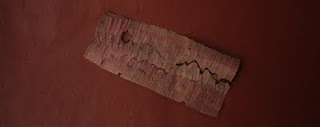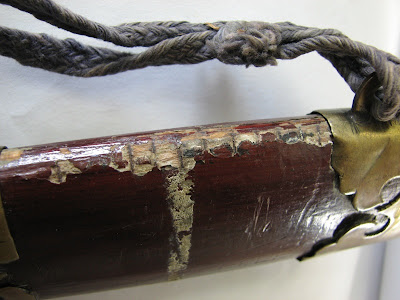I have a liking for old scabbards that are bound with wire and coated with a thin layer of black lacquer. I'm sure that I shouldn't really like them, because they are often not of the best quality....but none-the-less, I do. Usually considered to made in the late Qing and Republican eras. It quite normal for surviving examples to have lacquer missing and the the wire detached and displaced.
 |
| Period jian with wire and black lacquer scabbard |
In the next pic, you can see that the lacquer has worn exposing the copper wire, and without the lacquer to hold it in place, the wire moves around.
At the top centre of the pic, the round mark underneath the wire is a knot in the wood. Just below that you can see a groove in the lacquer where the copper wire sat. So, this scabbard was first coated in black lacquer, then bound with a single copper wire from mouth to chape, and then lacquered again before the fittings were added. The surface of the underlying wood is quite rough. This was probably done on purpose to give the lacquer a better key.
Here is another
jian scabbard from the same era. This one has had the wire and black lacquer removed and it has been re-coated in a brown lacquer.
The brown lacquer has chipped away to reveal marks left by the original wire wrap. What is interesting about this one, is that the black lines are grooves that have been burned into the wood. This wire had not been applied over a coating of lacquer, but must have been heated up as it was applied to the bare wood.
I imagine that would be quite a tricky job to do well. It's hard to know if burning a groove into the wood made the wires more secure, but this one certainly didn't survive.
The cord has fade to a rather nice blue-ish, purple-ish colour, but I suspect that it was originally black. The grip is bound in the same cord but it is not original to the
jian.









